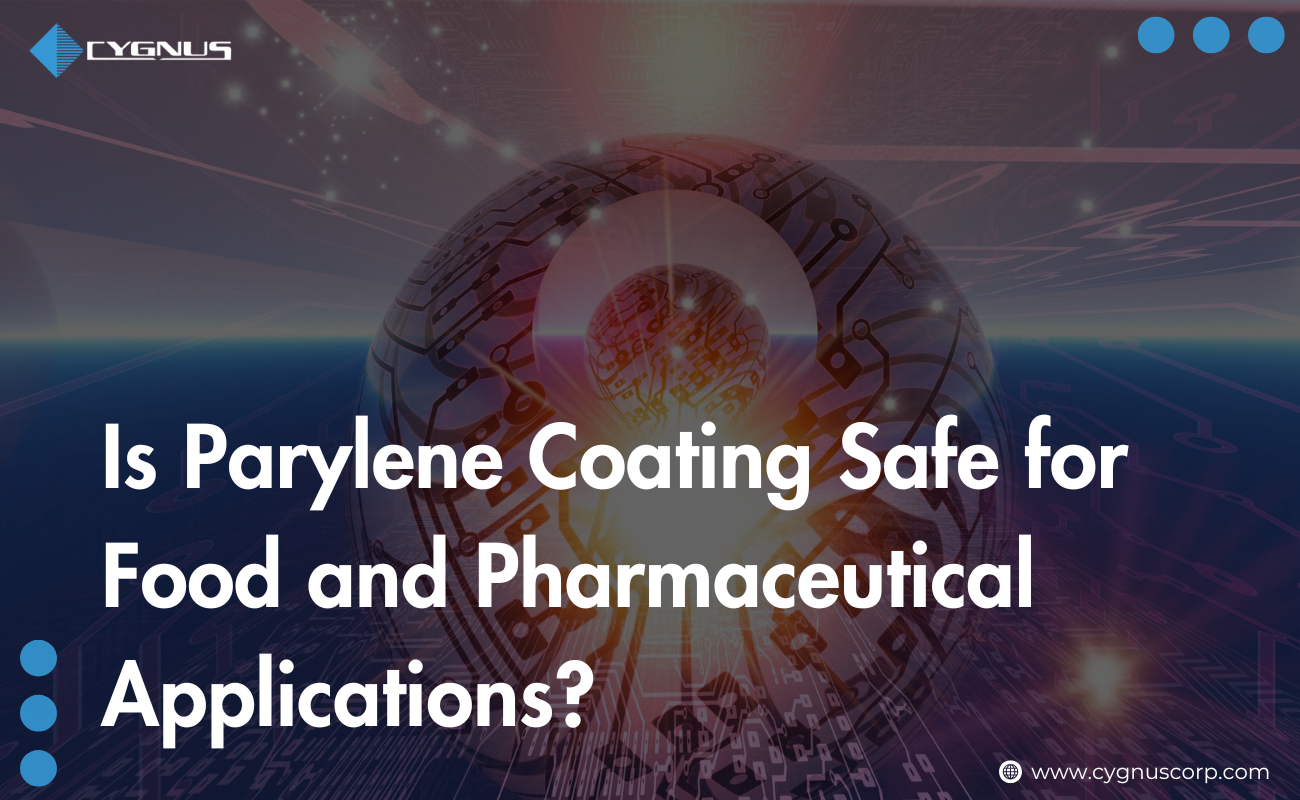When it comes to the food and pharmaceutical industries, safety and purity are non-negotiable. Every material that touches food, medicine, or processing equipment must meet strict standards to ensure there’s no risk to consumers. One material increasingly being used to protect these sensitive products is Parylene coating. But what exactly is Parylene, and more importantly, is Parylene coating safe for food and pharmaceutical applications? In this blog, we’ll dive deep into how Parylene works, its unique properties, its safety profile, and why it’s gaining popularity in industries where cleanliness and reliability are critical.
What is Parylene Coating?
Parylene coating is a thin, transparent polymer film applied as a protective layer over various surfaces. Unlike other coatings, Parylene is applied in a vacuum chamber through a process called chemical vapor deposition (CVD), which allows it to cover every part of an object even complex shapes and tight spaces—without leaving pinholes or gaps.
Unique Properties of Parylene Coating:
What makes Parylene stand out is its exceptional combination of properties:
- Biocompatibility: Parylene is recognized for being safe and non-reactive with biological tissues, making it ideal for medical devices.
- Chemical Resistance: It forms a strong barrier against acids, bases, solvents, and other corrosive substances.
- Pinhole-Free Protection: The coating forms a uniform, conformal layer, ensuring complete coverage without weak spots.
- Electrical Insulation: It’s often used in electronics because of its high dielectric strength.
Thanks to these features, Parylene is trusted in industries where even microscopic contamination or material breakdown can have serious consequences.
Common Industries Using Parylene:
Beyond food and pharmaceuticals, Parylene coatings are widely used in electronics, aerospace, automotive, and medical device manufacturing. Its ability to protect sensitive components from moisture, chemicals, and extreme temperatures makes it a go-to solution in high-stakes environments.
Regulatory Standards for Food and Pharmaceutical Safety:
When discussing Parylene coating food safety and Parylene coating pharmaceutical safety, it’s essential to look at the regulatory landscape. After all, no coating can be considered safe without proper approval and compliance.
Key Regulations: FDA, USP Class VI, and EU Directives
- Parylene FDA approval: The U.S. Food and Drug Administration (FDA) sets the bar for what can safely come into contact with food and pharmaceuticals. Certain types of Parylene, such as Parylene C and Parylene N, have been evaluated and are considered suitable for use as food contact coatings and in medical devices.
- USP Class VI: This certification, governed by the United States Pharmacopeia, tests for toxicity and biocompatibility in medical applications. Parylene coatings that meet this standard are regarded as safe for many pharmaceutical uses.
- EU Directives: Europe also requires strict testing for any material intended for food or drug contact. Parylene has been shown to meet these standards when applied and cured properly.
Certification and Compliance:
Any manufacturer using Parylene must ensure the specific grade and formulation meet relevant local and international regulations. Regular testing and documentation are required for ongoing compliance, especially when claiming a product uses food grade Parylene coating.
Why These Standards Matter?
These standards protect consumers and ensure that coatings will not leach harmful substances, react with sensitive materials, or alter the safety and efficacy of food or pharmaceuticals. When it comes to Parylene coating food safety and Parylene coating pharmaceutical safety, strict adherence to these standards is a must.
How Parylene Coating is Used in Food and Pharmaceutical Applications?
Parylene’s properties make it an ideal protective coating in many food and pharmaceutical settings.
Food Processing Equipment, Packaging, and Sensors:
- Food Processing Equipment: Parylene provides a barrier on machine parts that come into direct contact with food, preventing corrosion, contamination, and the buildup of bacteria.
- Sensors: In food safety monitoring and quality control, sensitive sensors are protected by a thin, food grade Parylene coating, ensuring they stay accurate and free from contamination.
- Food Packaging: Advanced packaging solutions use Parylene to extend shelf life and keep products safe from moisture and oxygen.
Pharmaceutical Devices: Syringes, Catheters, and Lab Instruments
- Medical Devices: Syringes, catheters, and surgical instruments benefit from Parylene coating pharmaceutical safety by gaining biocompatibility, cleanliness, and chemical resistance.
- Lab Equipment: The coating is used to protect sensitive laboratory instruments from chemicals and frequent sterilization, keeping them durable and reliable.
Benefits for Food and Pharma:
- Contamination Prevention: Parylene is non-toxic and prevents unwanted substances from reaching food or medicine.
- Non-Toxicity: Its inert nature means it doesn’t interact or react with what it touches.
- Chemical Resistance: Whether it’s strong cleaning agents or harsh ingredients, Parylene stands up to them all.
Safety Profile and Biocompatibility of Parylene:
A critical question is: Is Parylene coating safe? The answer, according to extensive testing and global regulatory bodies, is a resounding yes—when the right grade and application process are used.
Is Parylene Truly Inert and Safe?
Parylene is considered biologically inert, which means it won’t cause reactions with food, medicine, or living tissue. This property is a key reason for its increasing use in sensitive applications.
Research and Studies:
- Toxicity Testing: Parylene coatings that pass FDA and USP Class VI testing have been shown in studies to be non-toxic, non-carcinogenic, and non-mutagenic.
- No Taste or Odor Transfer: Tests demonstrate that food grade Parylene coating does not affect the taste, smell, or purity of food or medicine.
Comparison with Other Coating Options:
Compared to other protective coatings like epoxy or silicone, Parylene’s uniform coverage and lack of chemical leaching make it a superior choice for food and pharmaceutical uses.
Advantages and Limitations of Parylene in Sensitive Applications:
No solution is perfect, so let’s review both the upsides and downsides of Parylene.
Key Advantages:
- Durability: Withstands repeated cleaning, sterilization, and use.
- Chemical Inertness: Safe for food, medicine, and harsh cleaning routines.
- Biocompatibility: Non-toxic, making it a top pick for medical and food use.
- Conformal Protection: Coats every part of a product, even hard-to-reach spots.
Limitations and Concerns:
- Cost: Parylene application is a specialized process and may be more expensive than other coatings.
- Application Thickness: For some uses, achieving the desired thickness can be a challenge.
- Removal: Once applied, Parylene is extremely difficult to remove, so mistakes can be costly.
Case Studies & Real-World Examples:
Food Industry Applications:
A food processing company dealing with acidic sauces adopted food grade Parylene coating on its conveyor belts and mixing blades. After one year, equipment corrosion was nearly eliminated, and contamination complaints dropped to zero.
Pharmaceutical Device Success:
A medical manufacturer applied Parylene coating pharmaceutical safety standards to their new line of syringes. Not only did devices pass all biocompatibility and Parylene FDA approval tests, but patient feedback highlighted improved comfort and reliability.
Safety Testing & Testimonials:
Major testing labs have confirmed that Parylene coatings do not contribute harmful residues to food or pharmaceuticals and meet all international safety requirements. Industry testimonials praise Parylene’s reliability and ease of compliance with evolving regulations.
Conclusion:
So, is Parylene coating safe for food and pharmaceutical applications? When applied and certified properly, the answer is yes. Parylene coating food safety and Parylene coating pharmaceutical safety are backed by strong scientific evidence, rigorous testing, and international standards like Parylene FDA approval. If you’re seeking a solution that delivers long-lasting protection, biocompatibility, and peace of mind, food grade Parylene coating is worth considering for your business.
FAQs
Is Parylene coating FDA approved for food contact?
Yes, certain types of Parylene have received FDA approval for food contact, but always verify the grade and application with your supplier.
Can Parylene-coated medical devices be sterilized safely?
Absolutely. Parylene coatings are highly resistant to common sterilization methods, making them ideal for medical and lab equipment.
Does Parylene alter the taste, odor, or purity of food and medicine?
No. Studies and industry tests confirm that food grade Parylene coating does not impact taste, odor, or product purity.
Are there any risks or drawbacks to using Parylene in pharmaceutical manufacturing?
While Parylene is very safe and effective, costs may be higher, and the process requires specialized equipment. Always ensure correct certification for your application.




